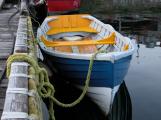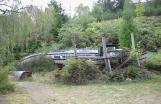1
Some Examples of Other Wooden BoatsThere were other wooden boat builders on the Sunshine Coast; people who needed to make a living from the sea, or people who just needed to get from point to point. Their skills varied, as did the type of construction and materials used.
J.Gunner, W.Thompson, J.Beaton and H.Roberts, and countless others all produced hand built boats used on the coast. They also passed on their skills and designs to many others. They milled their own wood and forged some of their own fittings. Various methods of construction were used; carvel (smooth skin), clinker (lap strake) and strip plank (on frame) to produce boats most suited to their needs.
Their designs and even some of their boats survived and can still be seen today. Some are preserved and on display, some are still in use, and some lay quietly returning to the earth and the forests that gave them life in the beginning.
2
14 FT. CLINKER BOAT BUILT IN 19511951
Sunshine Coast Museum & Archives, Gibsons, British Columbia, Canada
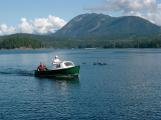
3
This 14 ft. clinker boat, ('Putt-Putt' is the affectionate local term used) has a single cylinder cast iron Wisconsin engine. It was built in 1951 by the Turner boatworks of Vancouver.The original owner was an Anglican Minister who fished in the Pender Harbour area of the Sunshine Coast. B. Polluck bought and restored the boat in 1997 and was happy to return the boat to the Sunshine Coast to the Museum's Maritime Collections. As well as display, the boat will be used for local events.
This photo was taken by SCMA board member, Mike Clements who has been involved with local maritime history for many years. In the photo are Larry Westake and Bee Jackson on a trial run with the boat; Bee for the enjoyment and Larry as the mechanic-on-call. Larry is a local boatbuilder of the glue and stitch method of construction. He has also modified Hubert Evan's double-ender, Georgia Strait Handtroller and developed a design that he calls 'Bright Sides'.
4
CLINKER BUILT BOAT 13 ft. Clinker Boat Built in 19361936
Sunshine Coast Museum & Archives, Gibsons, British Columbia, Canada
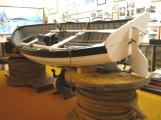
5
This 13 ft. clinker built boat was built in 1936 by James Beaton of Gower Point, Gibsons, British Columbia. This classic boat is powered by an inboard 2 horsepower Briggs & Stratton motor. It also has an unusal variable pitch propeller.Having a motor was a rare thing at that time when most people were rowing and sailing their small craft in pursuit of local salmon.
There are two rowing positions in the boat, so there is an indication that the owner did some mooching; a term used to describe the art of rowing and then flowing with the currents, winds and tides while fishing. See the story 'Hubert Evans' for more information on the local method of handtrolling.
The skiff had been in storage since WWII and arrived at the museum in prime condition for permanent display only.
6
MODIFIED HANDLINER BUILT IN 1965 Example of Carvel Hull See story 'Other Boats' for more info.1965
Granthams Landing,Howe Sound, British Columbia, Canada
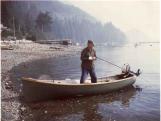
7
This example of a carvel hull was built in 1965 by Will Thompson. Will sold the boat to his sister, Inga Fenwick of Howe Sound. In this photo, Inga's husband, Fred is preparing his rod and gear for a day of fishing.Will Thompson had designed and modified this boat from lines taken from Roy Malyea's handliner. Roy worked with Hubert Evans (see the Evans Story) building double-enders. They often taught other local community members, such as John Corlett and Johnny Johnson, to build their own boats and to handline for salmon. Rumor has it that they temporarily used the old LePages Glue Factory building in Gibsons as a boatshed.
8
CHACK CHACK - 36 ft. Sailboat Built by Harry Roberts, early 1920's1920
Sunshine Coast Museum & Archives, Gibsons, British Columbia, Canada
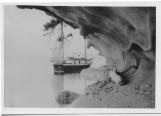
9
This is a photo of the 'CHACK CHACK', a 37 ft. sailboat built in early 1920's by Harry Roberts of Roberts Creek, Sunshine Coast, British Columbia. The photo was taken while touring the Gulf Islands near Vancouver Island, British Columbia. Recall from our map that it was Harry's grandmother that coined the name the 'Sunshine Belt' that would define our region as the 'Sunshine Coast'.The 'CHACK CHACK' was first named 'ODAMIT', for which Harry received much chagrin. Harry published a book about his adventures with this boat, called 'The Trail of Chack Chack'.
This was Harry's first sailboat and utilized lumber for the keel off the beach in Roberts Creek. Harry Roberts built the first mill, the first store and many community homes in the Creek area.
Harry's second boat was a work boat called 'LHF'. Harry would continue to build boats and homesteading on Nelson Island in the Pender Harbour area of the Sunshine Coast.
11
This 12 ft. clinker built boat, called the Nevada, was built by Darwin Carter in 1927. It has cedar planking, oak ribs, and a fir keel.The boat has two rowing stations which was important to early handliners of the era. The fisherman could switch seating easily for working the fishing lines or the herring rakes. See the 'Evans' story for more info about using herring rakes.
This boat was used on the Sunshine Coast in 1930 in the Gower Point area of Gibsons, British Columbia. The boat was rowed from Gower Point to Brittania Beach in Howe Sound by Ernie Easthope and Mavis Ann Carter.
Ernie Easthope is indeed of the family that is connected to the Easthope Engines; engines that powered a lot of the West Coast fishboats during the early 1900's. Ernie was about 70 years old at the time they rowed from Gower Point to Brittania. Mavis Carter is the daughter of Dudley Carter, Darwin's brother and the mother of the present owner, Michael Vaughan.
Micheal Vaughan is the brother of Anna Hanson, who is the carver who designed and sculpted our museum's sign and logo from beachcombed cedar. See this exhibits menu image and this exhibits last gallery image for more info.
13
The hulls of these two fishing boats are lying in decay, only a few feet from where they were built by Gunnar Jardine and his family in the early 1900's. Fishing sustained the family that lived in an isolated inlet of the Sunshine Coast.The posts from the old boatshed are visible in front of the hulls. These two boats have seen grander days when the commercial salmon fishing was plentiful in the 1930's and 1940's.
Gunnar and his family arrived in Dorston from Sweden when he was 10 years old. Both a government and a telegraph office were located in the community then. Dorston is located in the Sechelt Inlet, the inside northern waters of the Sunshine Coast, British Columbia.
Using only hand tools, the family built rowboats before they decided that they needed bigger boats for salmon fishing.
14
GUNNAR BESIDE HULL OF HIS BOAT 'ECHO' Sechelt Inlet in background23 September 2003
Dorston, Sechelt Inlet, British Columbia, Canada

